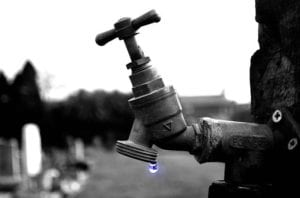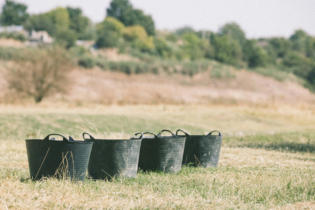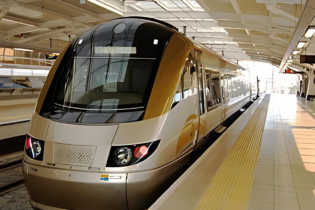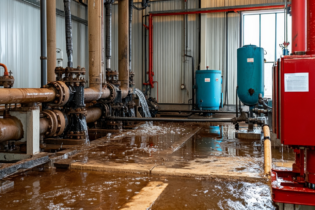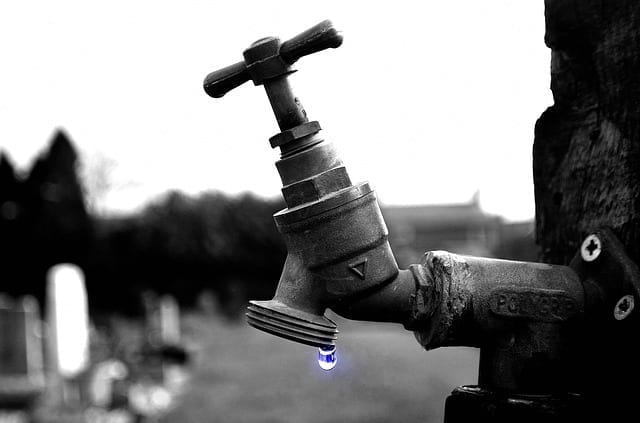 By Mike Axton and Brian Horton
By Mike Axton and Brian Horton
In the developed world, expectation is nothing less than a right. We open the tap, and we expect clean drinking water to flow. We switch on the lights, and bulbs must illuminate. We swim in waterways that must be safe and free from bacteria. Many resources that are critical for life are taken for granted with little regard as to how the water came to be in the tap or how the power got to the bulb. But beneath the surface, hundreds of thousands of kilometres of pipes and wires, connected by a myriad of pumps and valves make our cities habitable. Demand on these systems is rising ever higher.
Communities typically give little consideration to much of this critical infrastructure until it is no longer available. This occurred to 1.7 million residents of South Australia on the evening of 29 September 2016 (ABC 2016), when severe storms toppled power transmission towers and left their state in blackout.
The resource supply systems supplying our cities are currently pressed from numerous sides.
Many cities are facing the possibility that their infrastructure will run close to breaking point unless a shift in thinking is embraced. The confluence of urbanisation coupled with climate change, all superimposed on infrastructure that is decades old, is demanding new thinking.
The sustainable water activist website, Growing Blue, puts it like this: “Water is critical to future growth. But it can also become the major limiting factor to growth. For instance, businesses in water-scarce areas are already at risk, and so investors are increasingly taking water supply into consideration during their decision-making processes. Given today’s approach to water management, there is only so much growth that can be sustained. Gains in efficiency and productivity in water management and utilisation can reduce these risks and enable higher levels of sustainable growth, but how much higher? How far-reaching do those gains have to be?” (GrowingBlue 2011).
Ongoing demands for upkeep and expansion are expensive. As urbanisation increases in the coming 20 years, a relevant question is how can governments and water authorities manage the compounding pressures on limited resources, coupled with the adverse effects of climate change?
About 40% of the world’s population currently live in water-stressed areas (GrowingBlue 2011). With three billion more people added to the planet by 2050 (United Nations Department of Economic and Social Affairs 2015), water scarcity will soon become a matter of life or death (India 24X7 2016).
Ongoing demands for upkeep and expansion have an eye watering price tag. Water infrastructure is a multibillion-dollar asset that, if we were currently to overhaul and redo, would likely drain an entire city budget.
Sydney alone will spend $2.2 billion on water infrastructure in the next four years. As the tidal wave of urbanisation increases in the coming 20 years, how can governments and water authorities manage the compounding pressures on limited resources, coupled with the adverse effects of climate change? The public purse and taxpayer pool will have to somehow satisfy the living standards and expectations to which communities have become accustomed.
Water cannot be seen as an isolated utility, but an integrated variable in the quest to solve societies’ major problems. The world of water in a decade’s time will see people expect exactly the same level of service (if not better), yet the problem will have grown in complexity. More pipelines are only a part solution. It’s a paradigm shift that’s called for: the utility authorities will need to change people’s behaviour through better digital interaction with water.
If we fail to address the social mindsets driving city planning up until now, our problems will only get worse. But if we can use the digital world to sidestep this static analogue problem, we can turn crisis into opportunity. Digital technology allows us to step back and ‘smart up’ around the current cycle of water consumption and wastage. We can begin to see the grim reality of limited supply as the ‘dark room’ of innovation, whereby bold new ideas can be born to secure societal welfare in future uncertain times.
Method:
Moving from point a to point b
Up until now, we have lived in an analogue-based society. Our infrastructure is essentially ‘dumb’, marked by physical variables that function independently of one another. But as digitalisation and mobile technology continue to evolve at pace, the systems and spaces we inhabit will begin to catch up. Autonomous vehicles represent 1%of the automotive market worldwide today, but autonomous vehicles will secure a 35% advantage by 2040, and that will continue to rise (McDonnell 2016). Equally, the flow of water through a city’s network of steel and copper waterways will someday be analysed and controlled by smart grids. Our analogue world will become digitised.
Current ‘unintelligent’ analogue systems must be progressively transformed in order to change user behaviours through their enhanced interaction with the resource they are consuming. Real-time predictive analytics can draw the best out of our limited water supply by offering simple, intuitive, and meaningful insight into unique infrastructure. This, in turn, can be transferred into optimal and cost-effective management strategies that keep the water cycles healthy.
Getting one step ahead
Installing predictive maintenance applications also offers a possible solution. While the demand for freshwater is increasing by 64 billion cubic metres annually, the US alone loses 2.1 trillion gallons of treated water every year due to pipe breaks, leakages and mismanagement. This economic loss amounts to trillions, with a consequential impact on food prices, health and sanitation.
Connecting these assets into a real-time monitoring network would reduce the time it takes to discover and solve problems that historically appear only when a leak is physically identified. Data can be applied to motivate preventative maintenance and mitigated risk into the future. Smart meters, high-tech leak detection devices and water data software are starting to offer sophisticated and granular information on how to maximise profit, impact and environmental sustainability within water management and distribution systems (GE Water & Process Technologies 2016).
Imagine H2O’s annual global Water Data Challenge (Furlong 2016) sees promising startups that deliver water-focused data and analytics solutions compete for $50,000 in cash awards. “It will be impossible to tackle the global water challenge without basic data about our water resources,” said Tom Ferguson, VP of Programming for Imagine H2O. “These companies address some of the most pressing data problems in water, from utility process control to high accuracy weather forecasting.” (Furlong 2016).
He went on to comment about this year’s challenge: “A lack of actionable data poses significant challenges to businesses, landowners and governments managing water resources globally. Entrepreneurs responding to this problem are applying advancements in sensors, artificial intelligence, enterprise software and other IT applications to the water sector.” (Ferguson 2017).
The 2016 finalists provide an incredible demonstration of the power of water data to change how we manage this resource now and into the future. Here is what each is doing in this space:
ANDalyze is an Illinois-based company that produces water contamination testing products that use catalytic DNA technologies to detect and quantify chemical levels.
APANA is developing a water efficiency solution with analytics and reporting functionality to help businesses save money by saving water, reducing compliance risk, and strengthening operational sustainability.
Ayyeka is a startup based in Israel that offers “plug-and-play” water, wastewater, and environmental kits for the management and cyber-secure protection of infrastructure and resources.
Ceres Imaging, a startup currently operating in California and Australia that is offering end-to-end capture, processing, and delivery of high-resolution spectral imagery to help growers make important resource allocation decisions by demonstrating plant health without selling them hardware.
FarmX monitors soil, plant and environmental variables. It does this using its FarmMap Soil Probe and provides real-time analytics and precise recommendations to increase productivity and reduce costs by leveraging multiple data sources and the use of advanced machine learning processes.
FLUID, which is developing a water meter and corresponding app that helps people identify their water consumption levels, progress toward reduction goals, and detect leaks.
Ignitia is a Swedish startup working in Ghana and elsewhere in West Africa to deliver the most accurate forecasting technology for tropical weather, which can increase farm income by up to 80 percent.
Mapistry is a company offering a comprehensive environmental compliance platform for enterprises and facilities, including a centralized dashboard, State-specific forms, automatically configured notifications, and other features.
NJBSoft is an Arizona-based company offering regulatory compliance software tools and needs-specific software development, customization, integration, training and implementation services for civil and environmental engineering activities.
Sourcewater is building an online marketplace where energy operators, service companies, and landowners can buy, sell, recycle, treat, and dispose of water.
Water authorities that adopt programs of retrofitting these technologies on to their existing networks will gain the benefit of future-readying their infrastructure in the face of ever increasing demand.
Results and Discussion:
Contextualising the issue
An incremental approach to problem solving is no longer viable within the context of our interconnected
digital world. The water networks needs to be designed and planned under the bigger theme of climate change and urbanisation.
A drying climate and increasing demand from population increase will not ultimately be solved by throwing water solutions at them. If we are to ensure waters sufficient supply into the future, we have to adopt new ways of designing, using data and adopting digitised solutions to existing networks to manage the network intelligently. Smart cities are the only solutions to buffer the oncoming high tide of overpopulation.
Conclusion:
The sustainable water activist website, Growing Blue, makes a compelling point: “Given today’s accelerated pace of human development and the slow pace of managing issues as complex as water resources, tomorrow’s challenges are already at our door. Only by changing today’s approach to future water management and water productivity (economic output per drop) can we ensure a prosperous future.” (GrowingBlue 2011)
We need to harness the power of technology like never before if we want to outwit ever increasing demands.
* Mike Axton is a technical director at Aurecon and Brian Horton is a water leader at Aurecon in New South Wales.
 By Mike Axton and Brian Horton
By Mike Axton and Brian Horton

